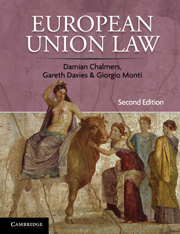Book contents
- Frontmatter
- Contents
- Map
- Preface
- Abbreviations
- Table of Cases
- Table of Treaties, Instruments and Legislation
- Table of Equivalents
- Electronic Working Paper Series
- 1 European Integration and the Treaty on European Union
- 2 The EU Institutions
- 3 Union Law-making
- 4 The EU Judicial Order
- 5 The Authority of EU Law
- 6 Fundamental Rights
- 7 Rights and Remedies in National Courts
- 8 Infringement Proceedings
- 9 Governance
- 10 Judicial Review
- 11 EU citizenship
- 12 EU Law and Non-EU Nationals
- 13 Equal Opportunities Law and Policy
- 14 EU Criminal Law
- 15 External Relations
- 16 The Internal Market
- 17 Economic and Monetary Union
- 18 The Free Movement of Goods
- 19 The Free Movement of Services
- 20 The Pursuit of an Occupation in Another Member State
- 21 Trade Restrictions and Public Goods
- 22 EU Competition Law: Function and Enforcement
- 23 Antitrust and Monopolies
- 24 State Regulation and EU Competition Law
- Index
17 - Economic and Monetary Union
- Frontmatter
- Contents
- Map
- Preface
- Abbreviations
- Table of Cases
- Table of Treaties, Instruments and Legislation
- Table of Equivalents
- Electronic Working Paper Series
- 1 European Integration and the Treaty on European Union
- 2 The EU Institutions
- 3 Union Law-making
- 4 The EU Judicial Order
- 5 The Authority of EU Law
- 6 Fundamental Rights
- 7 Rights and Remedies in National Courts
- 8 Infringement Proceedings
- 9 Governance
- 10 Judicial Review
- 11 EU citizenship
- 12 EU Law and Non-EU Nationals
- 13 Equal Opportunities Law and Policy
- 14 EU Criminal Law
- 15 External Relations
- 16 The Internal Market
- 17 Economic and Monetary Union
- 18 The Free Movement of Goods
- 19 The Free Movement of Services
- 20 The Pursuit of an Occupation in Another Member State
- 21 Trade Restrictions and Public Goods
- 22 EU Competition Law: Function and Enforcement
- 23 Antitrust and Monopolies
- 24 State Regulation and EU Competition Law
- Index
Summary
INTRODUCTION
This chapter considers economic and monetary union. It is organised in the following manner.
Section 2 considers the central four mechanisms of economic and monetary union. These are, first, free movement of capital between the Member States and between Member States and non-EU states; secondly, the adoption of a ‘single’ currency, the euro; thirdly, the commitment not to incur excessive deficits, a commitment policed by the Excessive Deficit Procedure where the Council of Ministers can sanction the Member State concerned for running an excessive deficit; and, fourthly, the issue by the Council of the Broad Economic Policy Guidelines (BEPG) on macro-economic, micro-economic and employment policy to Member States. Economic and Monetary Union is a field where differentiated integration applies. States have to meet certain criteria, the Convergence Criteria, before they can participate in the euro. Nine Member States, known as ‘states with a derogation’, have not met these criteria. In addition, Denmark and the United Kingdom have Protocols which allow them not to participate in the euro. Together, these eleven states are not bound by the EU monetary or exchange rate arrangements. In addition, no sanctions can be applied against them for running an excessive deficit. They are also excluded from certain procedures. They can participate neither in the government of the European Central Bank nor in the Euro Group, a group of finance ministers who consider coordination of economic policy in relation to the euro.
- Type
- Chapter
- Information
- European Union LawCases and Materials, pp. 712 - 743Publisher: Cambridge University PressPrint publication year: 2010

